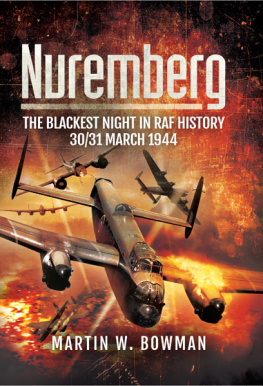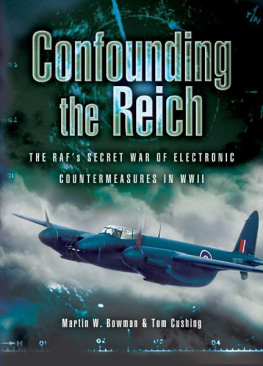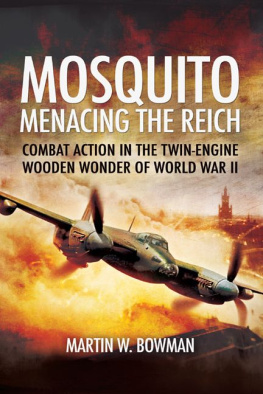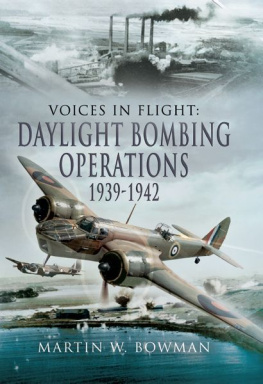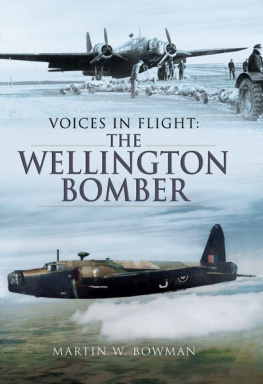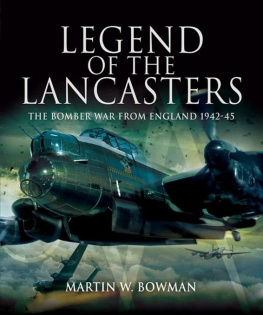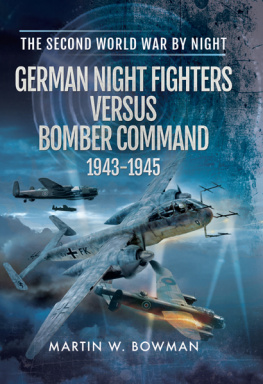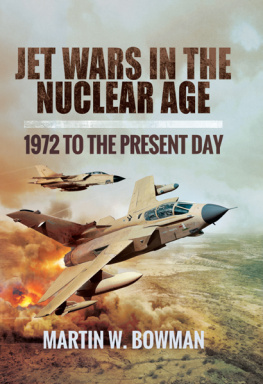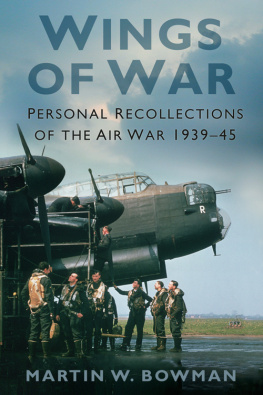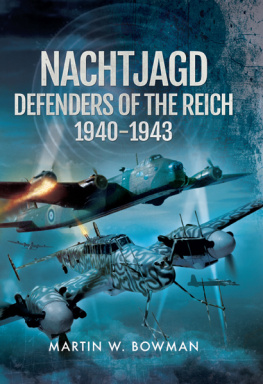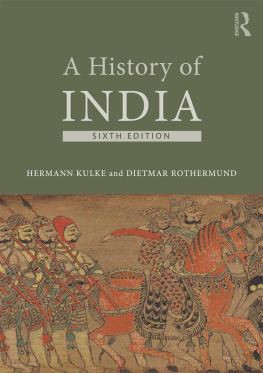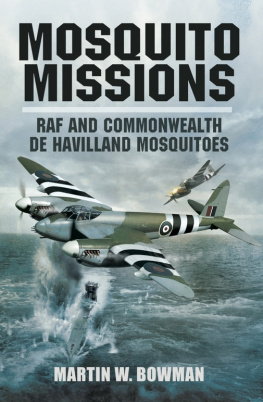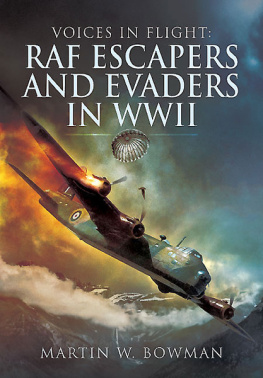First Published in Great Britain in 2016 by
Pen & Sword Aviation
an imprint of
Pen & Sword Books Ltd
47 Church Street, Barnsley, South Yorkshire S70 2AS
Copyright Pen & Sword Books 2016
ISBN: 9781473852112
PDF ISBN: 9781473852143
EPUB ISBN: 9781473852129
PRC ISBN: 9781473852136
The right of Martin W Bowman to be identified as author of this work
has been asserted by him in accordance with the
Copyright, Designs and Patents Act 1988.
A CIP catalogue record for this book is
available from the British Library.
All rights reserved. No part of this book may be reproduced or transmitted in
any form or by any means, electronic or mechanical including photocopying,
recording or by any information storage and retrieval system, without
permission from the Publisher in writing.
Typeset in 10/12pt Palatino
by GMS Enterprises PE3 8QQ
Printed and bound in England by
CPI Group (UK) Ltd, Croydon, CR0 4YY
Pen & Sword Books Ltd incorporates the Imprints of Pen & Sword
Aviation, Pen & Sword Family History, Pen & Sword Maritime, Pen & Sword
Military, Pen & Sword Discovery, Wharncliffe Local History, Wharncliffe
True Crime, Wharncliffe Transport, Pen & Sword Select, Pen & Sword
Military Classics, Leo Cooper, The Praetorian Press, Remember When,
Seaforth Publishing and Frontline Publishing.
For a complete list of Pen & Sword titles please contact
PEN & SWORD BOOKS LIMITED
47 Church Street, Barnsley, South Yorkshire, S70 2AS, England
E-mail:
Website: www.pen-and-sword.co.uk
Contents
To the Lancaster crews of 166 Squadron at Kirmington a broadcast of Grand National echoing in mess halls, hangars, crew-rooms and even in latrines, was a warning that the station had been alerted by 1 Group for a maximum effort operation that night. For Flight Sergeant Whitlock RAAF, a Londoner born in Constantinople [now Istanbul], the code words booming out that morning on the Tannoy public address system were to trigger a sequence of events and procedures which, though initially familiar, were to culminate in a night that Sidney Nicholas Whitlock would never forget.
The Nuremberg Massacre by Flight Sergeant Geoff Taylor RAAF a Lancaster pilot on 207 Squadron which was shot down on 18 October 1943 on Hanover. All seven crew survived their crash landing and became PoWs. Taylor ended up at Stalag 4B which he wrote about in Piece of Cake.
Chapter 1
Flashes of yellow flame pierced the darkness as Merlin XX engines were run up and eased back. Flight Lieutenant Brian B. Mill taxied Halifax LL287 S-Sugar on to the runway at Tempsford just to the north of Sandy in Bedfordshire and cleared his engines. The noise from its four airscrews, running at full throttle shattered the stillness of the night. A green Aldis lamp flickered to the left of the runway from the control wagon parked on the grass triangle. Flight Lieutenant Dennis R. Beale sitting in his second pilots collapsible seat tightened his safety belt and slammed shut the side window. It was quieter in the cockpit now. The roar from the clandestine bombers engines increased to a thunderous snarl, slowly, picking up speed with each second as the 138 Special Duties Squadron Halifax rolled smoothly down the runway, lifted and climbed steadily into the night, the navigational lights twinkling. The blue lights marking the edge of the runway whipped towards them at a fantastic speed as Mill hauled back on the control column and the Halifax yawed over the boundary markers. In the rear turret Flight Sergeant G. W. Kimpton saw the lights pass under him and he knew that they had left the runway. A chimney of a farmhouse flashed beneath his feet. Seconds later Kimpton looked down at the Great North Road, deserted now.
In the fuselage of the Halifax the rest of the crew and two Belgian Lieutenants, 27-year old Albert Giroulle (Troilus) and 23-year old Robert Deprez (Lucullus) were braced against the main wing spar. They had spent the day nervously waiting to board the Halifax at Gibraltar Farm to be parachuted into occupied Europe to assist the secret armies engaged in covert warfare against the Nazis. The Special Duty Squadrons had amassed a wealth of experience on varied cloak-and-dagger missions in the Low Countries and France and as far afield as Austria, Norway, Poland and Czechoslovakia. Osric 27 had been laid on by the Special Operations Executive using the maximum effort raid on Nuremberg on Thursday 30 March 1944 as cover. SOE used several lovely country mansions deep in woods and thickets in remote parts of Britain as club houses and dormitories for secret agents. Apart from carrying out acts of sabotage, the resistance movement in Belgium had a very efficient escape line for downed Allied airmen. Capture however, spelled almost certain death and there were many traitors - male and female who were prepared to betray these brave operatives and their contacts. The Belgians saw nothing and knew nothing until the rear gunners voice came over the intercom.
Warrant Officer2 Frederick Anderson RCAF the 21-year old Canadian bomb aimer from Winnipeg pulled off his leather gauntlets and dragged a pair of newly washed white silk gloves from his pocket and thrust his hands into them. He screwed and twisted the silk until his fingers fitted smoothly into the sockets. The heavy flying gloves were too bulky for him to feel sensitively in the blacked-out nose for the delicate switches on the bomb panel. Flying Officer Eric Francis DFC the navigator who was from Hessle in Yorkshire laid down his dividers, swallowed his two Wakey-Wakey pills and debated whether he should slip into the nose when they sighted the drop zone just to the south of Antwerp. Like Troilus and Cressida, a tragedy by William Shakespeare, Osric 27 too would end in disaster. Five of the crew were the first of fifteen men shot down that night.
Sir Arthur Travers Harris, a compact, silent, bull-terrier of a man with one outstanding characteristic, a bitter hatred of the Hun and all that he stood for, was 51 years old, born in Cheltenham, Gloucestershire on 13 April 1892, the son of a member of the Public Works Department of the Indian Civil Service. At the outbreak of war in 1914 he had joined the Rhodesia Regiment as a boy bugler. After taking part in the German South-West African campaign in 1915 he left for England and enlisted in the RFC and was posted to France. He ended the war as a major with an AFC. In the next twenty years Harris commanded bomber squadrons and from 1933 to 1937 he served in staff positions at the Air Ministry. He took command of 4 Group in 1937 and was Head of the RAF Purchasing Mission in America in 1938 before taking command of 5 Group in 1939, a position he held until 1940 before acting as Deputy Chief of Air Staff at the Air Ministry. On 22 February 1942, having been recalled from the USA where he was head of the RAF Delegation, Air Chief Marshal Arthur Harris CB OBE arrived at High Wycombe to take over as commander-in-Chief of RAF Bomber Command.
Throughout the Battle of Berlin Bomber Harris believed in a state of devastation in which surrender is inevitable. Perhaps a raid on the birthplace of Nazism would go some way to proving it even though, since the end of November 1943 Harris had despatched thirty-four major assaults on Germanys sixteen of them against the Big City and still no German surrender was in sight. Thirty-five major attacks were made on the Big City and other German towns between mid-1943 and 24/25 March 1944; 20,224 sorties, 9,111 of which were to Berlin. From these sorties, 1,047 aircraft failed to return and 1,682 received varying degrees of damage. At the start of battle Harris had predicted that Berlin would cost between 400-500 aircraft but that it would cost Germany the war. He was proved wrong on both counts. The Battle of Berlin had proved not so much a gallant failure, but rather, a defeat. But very shortly Bomber Command would be called upon to support the invasion of Europe and Sir Arthur Harris was anxious to strike at one last major target before this happened. Nuremberg was a target he knew was very dear to Winston Churchill the British Prime Ministers heart.
Next page
